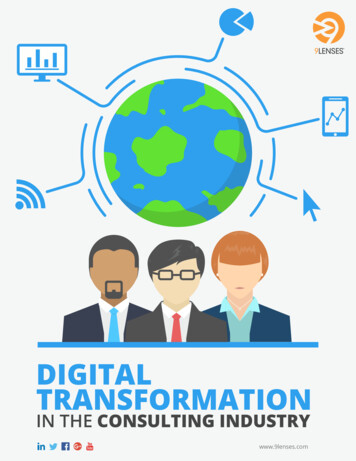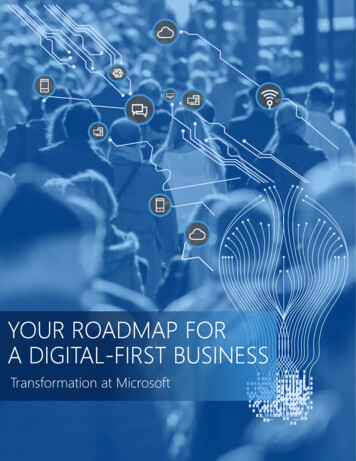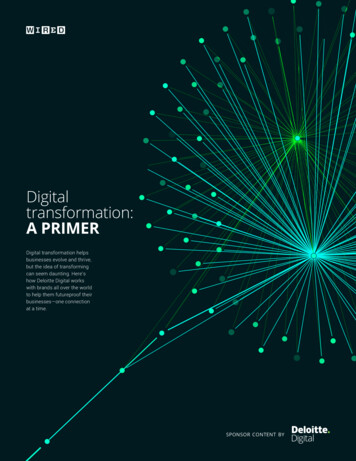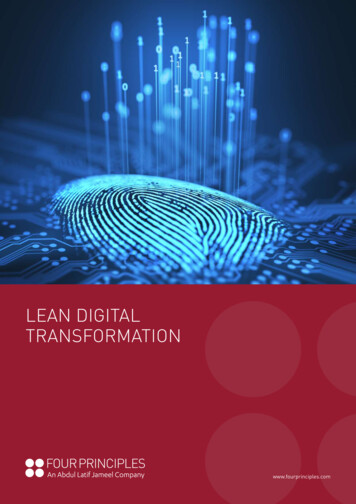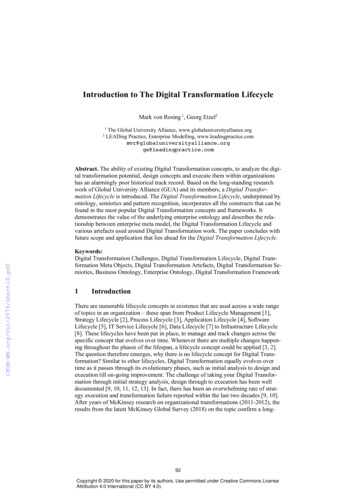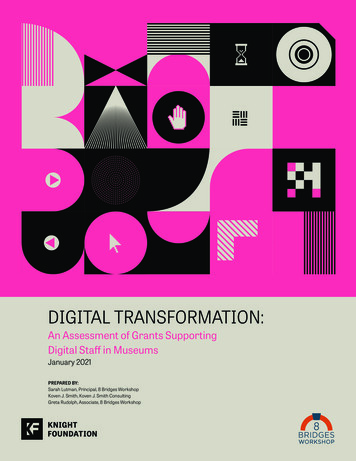
Transcription
DIGITAL TRANSFORMATION:An Assessment of Grants SupportingDigital Staff in MuseumsJanuary 2021PREPARED BY:Sarah Lutman, Principal, 8 Bridges WorkshopKoven J. Smith, Koven J. Smith ConsultingGreta Rudolph, Associate, 8 Bridges Workshop
ContentsExecutive Summary 31. Background and Introduction 52. Capacity Growth: Patterns and Themes 73. Recommendations 104. Conclusion 14Appendix I: List of Interviewees 16Appendix II: Research Methodology 17Digital Transformation: An Assessment of Grants Supporting Digital Staff in Museums 2Appendix III: Consultant Backgrounds 19
Executive SummaryKnight Foundation believes that the digital space holds significant opportunities for culturalinstitutions, and in recent years has intensified its work to help organizations createvaluable digital content. Museums that do not invest in digital capabilities and offeringswill miss important connections with potential audiences. This deficiency also seems likelyto erode the relevance of the arts in society as audiences spend increasing amounts oftime online.1In early 2018, Knight Foundation approved 970,000 in grants that aimed to raise thedigital profiles of eight museums by supporting the costs of positions dedicated to digitaland technology work. These digital positions would conceive, plan, and implement digitalstrategies that improve the visitor experience and expand audiences. Seven of the initialeight grantees proceeded to hire their digital positions; four of the museums’ hires remainin their positions as of this writing.All seven grantees showed growth in digital capacity during the grant period. And, thoughthe grantees differed significantly in their budget sizes and in the scope of their digitalprograms, several themes surfaced repeatedly during the research: Size and capacity: Neither the budget nor staff size of the museum wascorrelated with an increase in capacity or success in delivering high-impactpublic-facing initiatives. Audience impact: The grants supported the creation of audience-facing digitalinitiatives at all seven museums. Though this report includes examples of suchprojects, these projects should not overshadow the significant but less visiblecontributions to digital capacity made by the hires. Strong hires: The digital hires from this set of grants were universally capable,and all were adaptable to shifting responsibilities and requirements. All the hiresreported that the positions provided opportunities for career growth. Role-scoping: The digital hires performed significant work not captured in theirposition descriptions. Salary challenges: Paying market-rate salaries for these positions was astruggle for all seven grantees, even with Knight’s grant support. Each museumaddressed the challenge in its own way. Executive leadership: Sustained digital capacity-building was correlated with1 Andrew Perrin and Madhu Kumar, “About Three-in-Ten U.S. Adults Say They Are ‘Almost Constantly’ Online,” Pew ResearchCenter, July 25, 2019, et/Broadband Fact Sheet,” Pew Research Center, June 12, 2019, ternet-broadband/.Digital Transformation: An Assessment of Grants Supporting Digital Staff in Museums 3The grant period presented a series of unprecedented challenges for museums and forsociety at large. The COVID-19 pandemic forced many museums to close their physicalspaces, pivot to remote work and add more digital programming. The racial justicemovement accelerated in 2020, which itself caused a reckoning with museums’ histories ofEurocentrism and lack of staff and board diversity.
a highly involved executive leader and/or leadership team who were invested inthe new hire’s success. Technical infrastructure: A majority of the grantees’ technical infrastructureswere not adequate to support the stated goals of the hired positions. The needto address this infrastructure gap before pivoting to public-facing initiatives wasnot always well understood by the museums’ leadership teams.These themes led to a set of recommendations for investing in the digital capacity ofmuseums. Highlights of these recommendations include:Readiness Assess the museum’s current IT infrastructure on the front end of anyinvestment in staffing. This factor is critical to the consideration of whether amuseum is likely to achieve its proposed digital goals. Integrate and align digital strategy with organizational strategy. Museumsthat saw the most significant and lasting change had clear goals and roadmapsaligned with overall organizational strategy and planning. Create a scope of work and compensation plan that are aligned withavailable resources. The pay scale disparity between the for-profit tech andmuseum sectors can create complications that will need to be accounted for.Armed with a clear sense of scope and purpose, a museum can avoid creating“unicorn” positions that combine heterogeneous skill sets. Ensure that new digital hires have adequate resources to executeprojects. Digital initiatives require the commitment of resources beyond thehire’s salary in order to be successful.Strategy Ensure executive vision and support for digital strategy. Sustained digitalcapacity-building was correlated with a highly involved executive leader and/orleadership team who were invested in the new hire’s success. Communicate the purpose and responsibilities of the new position tomuseum staff. Many hires described having to explain and justify the scope oftheir work to colleagues. Focus on capabilities, not projects. An overemphasis on project workgenerally hindered progress on foundational capacity-building initiatives.Digital Transformation: An Assessment of Grants Supporting Digital Staff in Museums 4Resources
1. Background and IntroductionIn early 2018, Knight Foundation approved eight three-year grants that were intendedto help museum recipients to conceive, plan and implement digital strategies that wouldimprove the visitor experience and expand audiences.2 Though not designed as either acohort-based or other more formal grant program, the grants were all made at the sametime and for this same purpose. They partially funded a new staff position at each museum,supporting an individual who could focus on digital work, specifically audience-facingexperiences enabled by technology.Knight selected the grantees by inviting multiple museums in its geographies to apply,and interviewing promising applicants before making final decisions. During the reviewprocess, Knight looked for leadership support of the new position, an understanding ofthe digital role as being separate from IT and a sense that the new position would besustainable at the end of the grant period. Among the grantees selected, each museumhad different digital needs and different starting points. Each crafted its own positiondescription and goals, in consultation with Knight. The position descriptions wereconfirmed before the grantees signed their grant agreements.Grant funds were structured so that the grantee organizations were responsible foran increasing portion of the position’s salary in each of the three years. Knight providedapproximately half of the amount of wages and benefits over the three-year period, withKnight generally providing 75 percent of the position cost in the first year, then 50 percent,then 25 percent in the subsequent years. The grant amounts differed across the museumsand ranged from 71,482 to 179,401,3 with all the grants totaling 970,000.Grantees and the original job titles for the positions supported are as follows: Detroit Institute of Arts: Digital Experience Designer Harvey B. Gantt Center for African-American Arts Culture, Charlotte, NC:Director of Technology Innovation2 One of the original grantees, the Fabric Workshop and Museum in Philadelphia, canceled the grant in early 2020 becauseof leadership changes. The grant-funded position was never filled at that museum, and we therefore were not able to studyany results from that museum.3 This range does not include the grant to the Fabric Workshop and Museum, which ended early after fundingtotaling 34,320.Digital Transformation: An Assessment of Grants Supporting Digital Staff in Museums 5Without museum staff focused on digital programming, museums may not understandthe steps necessary to reach and engage digital audiences. Further, even in cases wheremuseums have staff members working in this area, Knight observed that they were notalways well-connected to the organization’s leadership or its strategic vision and wereoften limited to IT- or marketing-focused roles. Thus, these grants aimed to build digitalcapacity at the grantee museums by supporting the creation of a new permanent full-timeposition devoted to the development of audience-facing digital engagement.
Lowe Art Museum, University of Miami: Director for DigitalEngagement Strategies Museum of Contemporary Art Detroit: Tech New Media Curator Pennsylvania Academy of the Fine Arts, Philadelphia: Director ofMuseum Technology San Jose Museum of Art: Manager of Interactive Technology The Wolfsonian–Florida International University, Miami Beach: Digital Projects &Community OrganizerKnight Foundation subsequently engaged 8 Bridges Workshop, a St. Paul, Minnesota–based firm, and Austin, Texas–based collaborator Koven J. Smith to evaluate the earlyimpact of the museum tech staffing grants. Between August and October 2020,consultants researched the grantees’ work through document review, interviews withkey personnel and review of digital outputs such as websites, archived video of streamedprogramming and social media content. Consultants assessed digital capacity growth forindividual grantees and for the group.Both developments have had cascading impacts on the seven museums. All had to closetheir physical spaces and pivot to working remotely, while at the same time increasetheir responsiveness to events in their local communities and around the world. Further,the pandemic offered museums the opportunity to respond to local shutdowns bycontinuing to serve the public with creative digital programming. Museums fashioned theirresponses differently.Museums across the United States have also faced a turbulent reckoning in 2020 withrespect to perceived Eurocentrism, staff and board diversity and the pace of change inresponse to these issues. This has resulted in increased demands for public accountabilityfor museums and their leadership. Digital hires were in some cases caught in the middleof this, and the scope of their responsibilities changed suddenly as a result. Several of thehires were faced with continuing to deliver their work amid volatile leadership changes oremerging public pressure on multiple staff members to urgently address inequities.Several of the museums reported large increases in participation in their onlineprogramming, with audiences coming to digital programming from across the UnitedStates and around the globe. The timing of Knight’s support for a digital hire wasparticularly fortuitous, as it helped position the more nimble museums in the group to takeadvantage of the increased public interest in online cultural experiences brought about byshutdowns in 2020.Digital Transformation: An Assessment of Grants Supporting Digital Staff in Museums 6The year 2020 has presented a series of unprecedented challenges for society at large.These challenges form the backdrop to Knight’s digital capacity-building grants and shouldbe taken into account as progress is assessed. Two primary societal themes are especiallyimportant to note: the COVID-19 pandemic, unfolding since March, which forced the publicclosure of all seven museums, and the racial justice movement that has accelerated sincethe killing of George Floyd in May.
2. Capacity Growth: Patterns and ThemesEach of the seven museums showed improvement in digital capacity during the grantperiod. The improvements represent a range of progress, as calculated as the changebetween a museum’s initial and final Readiness scores using the model found in the DigitalReadiness and Innovation in Museums report. The model was developed with input fromseveral consultants and field experts. Note that the measurement methodology valuedthe increase in each museum’s capacity; it did not compare one museum’s total capacityagainst another’s. Some museums started with lower absolute capacity but improvedsignificantly, while others had stronger baselines but showed less improvement.Taken as a whole, the museums’ progress—and the obstacles they faced—revealedpatterns that are highlighted in this section. These patterns have implications for bothgrantmakers and museum leaders who seek to build digital capacity effectively. Thepatterns can broadly be grouped into themes that arose while the museums were definingand hiring the position; themes encountered while the digital hire was performing thework; and themes that were revealed through this evaluation.Patterns in hiringDespite the difficulties in job definition and salary levels detailed below, museums were ableto attract dynamic new talent to their organizations. All the digital hires interviewed werecapable leaders who were able to diagnose their respective situations and push their museumsin helpful and in some cases innovative ways. For their part, the digital hires described theirpositions as equal parts challenging, rewarding and frustrating. Many of the hires weregiven leadership opportunities, and almost all were regarded as leaders by colleagues. Thisimpressive group of individuals seems likely to see rising careers in the museum tech field(indeed, one of the hires has already moved to a prominent position at the Smithsonian, andanother has been promoted to a deputy director position). The group is exceptional.Museums placed the digital hires differently in their organizational structures.None of the museums had a large and robust digital department for the hire to join, so theplacement of the position in the organizational chart was different in each instance. The lackof an obvious “digital hierarchy” in these museums created continuity problems for some ofthe hires—three of the seven museums changed the hire’s reporting structure at least onceduring the review period.Initially, the hires reported to an executive director or equivalent (three museums); tocuratorial department leadership (two museums); to a deputy director (one museum); and toaudience and engagement departments (one museum). Uniformly better growth in capacitydid not correlate with any particular reporting relationship, but all the digital hires reportedthat it was necessary to have meaningful and consistent access to museum leadership.Digital Transformation: An Assessment of Grants Supporting Digital Staff in Museums 7Museums were able to attract dynamic talent.
Museums had difficulty paying market-rate salaries for tech positions.Digital hires and their hiring supervisors shared that they had difficulty recruiting talent forthe Knight-funded positions given the available salary dollars. In instances where moneywas particularly tight, museums could not increase their salary offers because they simplydidn’t have the funds to do so. In more than one instance, a strong candidate could notaccept the position at the salary offered. In other instances, museums spent all availabledollars to accommodate a higher salary, but then had little left to support the work of theposition—development costs, software licenses and critical hardware were left unfunded.This was a particular challenge for the university-affiliated institutions, as the positionswere often required to fit existing HR categories with corresponding salary ranges, evenwhen additional funds for the positions were available. At least one institution workedaround this limitation by expanding the definition of the position to include interpretiveand executive duties, which provided access to an additional range of job categories withhigher corresponding salary ranges.The disparity between salaries in the museum and tech sectors complicates this further.More than one hiring manager expressed surprise that some candidates for the positionswere expecting salaries even higher than that of the executive director. Museumsaddressed this problem in unique ways, but this will remain a factor for any programseeking to fund tech staff in museums.Accrued technical debt hindered progress with both capacity-building andaudience-facing digital initiatives.Technical debt—the result of years of delayed decisions to update or implement criticalsoftware, hardware and training—often had to be addressed before significant audiencefacing work could move forward. Technical debt also manifested in a lack of digital literacyon the part of staff members; several of the hires reported difficulty with transitioning staffto remote work due to a lack of familiarity with basic calendaring and communicationstools. While the hires for the most part did excellent work addressing this deficit, theyalso expressed frustration because this was not the work they were hired to do, nornecessarily the work for which they were most qualified. Hires who came to their museumsexpecting to create new digital initiatives instead found themselves needing to first replace15-year-old desktop computers. Museum leadership did not always appreciate the need toaddress technical infrastructure before proceeding with other projects; several hires weretold to work exclusively on audience-facing initiatives, despite the available technology notbeing up to the task.The hires performed “other duties as assigned” not captured in the originalposition descriptions.Apart from IT and infrastructure work, the digital hires mentioned other tasks thatdiverged from their roles as initially defined, but which they nevertheless viewed asimportant to their success. More than one worked to raise funds to support the digitalprojects they were tasked with developing. At one museum, the digital hire created aDigital Transformation: An Assessment of Grants Supporting Digital Staff in Museums 8Patterns in the work
physical meeting room for museum staff, which raised the overall awareness of digitalinitiatives. At another, the hire was tasked with refurbishing an auditorium space.Most museums developed external partnerships in order to executedigital projects.Six of the seven museums developed or expanded partnerships with outside entities inorder to execute digital projects. These partnerships were in some cases transactional (forinstance, one hire leveraged a personal relationship with another museum to acquire theirunused equipment), but in other cases were more future-focused (two academic museumspartnered with university faculty for digital humanities initiatives). Because most of thehires were the only technology positions in their museums, these external partnershipswere critical to delivering new projects.Patterns in outcomesAll seven museums made significant strides toward involving multiple departments androles in planning and executing digital projects. This resulted in a better integration of digitalacross departments, with initiatives that touched a majority of departments in each museum.Virtually all the hires were members of cross-functional teams, and in some cases they wereresponsible for creating those teams. The cross-functional approach sometimes enabled fasterand more effective digital “pivots” in response to COVID-19; one museum was able to leveragethe hire’s technical skills and access to leadership to form a quick-response digital team thathad several new initiatives up and running within weeks of the beginning of quarantine.Audience research and outcomes tracking remained weak pointsfor most museums.There was some improvement here, with all museums making some effort to betterassess audience impact, but four of the museums studied showed no increase in capacityin this area. (This reflects a trend in the wider field; only 16 percent of art museums inthe Digital Readiness and Innovation in Museums report took a proactive and carefulapproach to data collection,4 and 68 percent of art museums gathered only anecdotal orbasic audience feedback.5) Very few of the museums tracked specific outcomes or hadpredefined metrics of success for their digital initiatives, which made objective evaluationof the success of any one initiative difficult.Important work did not always result in immediate audience-facing outcomes.Though audience-facing projects were an important indicator of digital progress for manyof these museums, more durable capacity-building work did not always result in a visibleproject. Museums spent time investing in infrastructure that will build the capacity to expandaudience-facing projects in the future, or addressing long-standing technical debt that4 Digital Readiness and Innovation in Museums: A Baseline National Survey, Knight Foundation (October 2020), 21.5 Digital Readiness and Innovation in Museums, 25.Digital Transformation: An Assessment of Grants Supporting Digital Staff in Museums 9Cross-departmental planning and digital integration improvedacross all museums.
is foundational to the organization’s efforts. One museum upgraded its IT vendor, severalinstalled WiFi in public spaces and two museums upgraded A/V components in their publicspaces. These improvements had high impact, but were not always visible to the public.3. RecommendationsKnight’s initial grant program reflects a promising approach to increasing digital capacityin museums by developing in-house expertise. Every museum increased its digitalcapability, some by leaps. During a year of unprecedented challenges, digital capability wasurgently needed and Knight-funded digital staff were in a position to help their museumsrespond creatively and effectively. Leaders gained new perspectives on the humanresource requirements for digital engagement; talented digital hires had the opportunity torise to challenging new assignments.While the overarching finding is that investment in new positions—people who cancontribute new digital skills and knowledge—is an effective approach to strengtheningdigital capacity, dollars invested did not always produce sustainable change. The questionfor museums and those who support them financially is how to determine readiness for acapacity-building investment, to be sure that the organization will be able to benefit fromthis kind of funding boost. Consider these steps to improve the likelihood of success:The museums in this group that made the most significant and lasting capacityimprovements were those that assessed and addressed their technical debt. An independentassessment of a museum’s current technical status and capabilities and an assessment of itsoverall digital literacy may be warranted before proceeding to supporting a new position.Integrate digital strategy with organizational strategy.Developing a digital strategy, methodology or roadmap is a key step toward creatingsustainable capacity improvements. While an explicit and stand-alone digital strategy isnot necessarily required, the museums that saw the most significant and lasting changeall had clear goals and roadmaps, a mandate for integration of digital strategy acrossdepartments and executive directors who were invested in both the outcomes and thetactics for achieving their goals.Develop a plan for adequate compensation.Know ahead of time that even a salary at the high end of a museum’s pay scale may be lowfor a candidate coming from the for-profit tech sector. Museums hiring digital talent willneed to have a strategy in place for addressing possible salary complications and shouldbe prepared to negotiate to hire first-choice candidates, provide training for candidateswith less experience or otherwise adapt to market contexts.Digital Transformation: An Assessment of Grants Supporting Digital Staff in Museums 10Accurately assess technical debt before defining a new position.
Ensure that new digital hires have adequate resources to execute projects.Several of the museums in the group expected that most of their hoped-for projects couldbe realized by leveraging external partners or free software. Unfortunately, this translatedin some instances to an assumption that there was not a need for a budget line to supportdigital development. As a result, dollars were simply not available for prototyping, softwarelicensing, media production, hardware purchases and the like. This, more than any othersingle factor, held back a number of promising audience-facing initiatives.Provide professional development opportunities for hires.Especially when hires are siloed as single-person departments, connections with otherdigital staff in similar roles at other institutions can be helpful, as can their involvementin professional organizations such as Museum Computer Network or other field-widelearning and networking opportunities.Ensure executive vision and support for digital strategy.Sustained digital capacity-building was correlated with a highly involved executive leaderand/or leadership team who were invested in the new hire’s success. A leader whounderstands digital within the museum’s overall strategic context can have a significantimpact on a digital hire’s success.All seven hires spoke of having to explain the scope of their work to colleagues when theyarrived or were moved into the new roles. Because other staff members didn’t alwaysunderstand the purpose of the new digital position, the hires often ended up performingsupport/IT duties. Executive directors should take an active role in explaining the hire’s roleto other staff members.Focus on capabilities, not projects.The development of public-facing projects was not an accurate predictor of capacitygrowth in the cohort, and in some cases an overemphasis on project work seemed tohinder other capacity-building initiatives. Audience-facing initiatives had the greatestimpact when they were realized as components of organizational strategy rather than asends on their own.Digital Transformation: An Assessment of Grants Supporting Digital Staff in Museums 11Communicate the purpose and responsibilities of the new position tothe wider staff.
Examples of New Audience-Facing Digital CapabilityThe Gantt Center’s Unmasked seriesBefore the pandemic, the Gantt Center hosted a series of in-gallerydiscussion panels called Talk About It Tuesday. These programs wereenhanced by the digital role; the museum installed WiFi in the gallery with acaptive portal and live polling capability, so that panelists could see real-timeaudience responses. Following the museum’s closure due to COVID-19, theGantt Center turned this program into the virtual series Unmasked. TheUnmasked events are live-streamed on YouTube and include audiencechat and interaction. Recent topics include We Can’t Breathe, RedefiningProtect and Serve, and Change from the Inside. The Gantt Center reporteda significant increase in audience size with participants coming to theprogram from across the United States and several foreign countries.The Wolfsonian’s Miami Beach Deco WalkEarly in the grant period, the Wolfsonian’s hire created a walking tour thattakes a visitor through the Miami Beach Art Deco historic district. The visitorcan take the self-guided tour either through a text guide or an app that wasDeco buildings and objects in the museum’s collection. Initial user testingwas favorable.San Jose Museum of Art’s digital publication 50X50: Stories ofVisionary Artists from the Collection50X50 is a digital publication released to coincide with the San JoseMuseum of Art’s 50th anniversary. It was released during the pandemic, butit was conceived of as digital-based publication before the onset of COVID19. 50X50 features profiles of fifty artists from the museum’s permanentcollection, along with images of their work, video interviews, and explanatorytexts. Interviews highlighted this publication as a major milestone in themuseum’s digital programming capacity.Digital Transformation: An Assessment of Grants Supporting Digital Staff in Museums 12developed by the digital hire. The guide draws parallels between specific Art
11/23/2020image-517Copy of IMG 3590 ed.jpg (5184 3456)Detroit Institute of Art’s mobile tour with LuminDetroit Institute of Art was the first art museum to use Google’s Tangotechnology to create a mobile tour called Lumin. Lumin uses 3D mappingand smartphone augmented reality technology so that visitors can explorethe museum while seeing augmented images and information on their ownphones. Technological complications currently prevent the museum fromusing and expanding Lumin, but the development of Lumin was cited as abreakthrough project that helped museum leaders understand the potentialof virtual visiting capability.Museum of Contemporary Art Detroit’s Daily Rush platform1/1Museum of Contemporary Art Detroit launched a new media platform calledDaily Rush. The museum’s digital hire spent the early part of his tenuresuccessfully applying for an additional grant to support this work. Daily Rushpresents the work of visual artists and filmmakers, structured as “seasons”organized around emerging ideas in digital technology and culture.Digital Transformation: An Assessment of Grants Supporting Digital Staff in Museums 17Copy of IMG 3590 ed.jpg
4. ConclusionThis study documents significant progress among Knight Foundation’s museum techstaffing grantees toward building greater digital capacities in their organizations. Digitalhires funded with Knight dollars were critical to making this growth possible.Research also documented the obstacles to digital capacity-building in the museumenvironment. Lack of technical infrastructure, insufficient digital knowledge
Digital Transformation: An Assessment of Grants Supporting Digital Staff in Museums 6 Lowe Art Museum, University of Miami: Director for Digital Engagement Strategies Museum of Contemporary Art Detroit: Tech New Media Curator Pennsylvania Academy of the Fine Arts, Philadelphia: Director of Museum Technology San Jose Museum of Art: Manager of Interactive Technology




